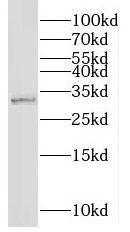Products
NMNAT1 antibody
| Synonyms: | Nicotinamide/nicotinic acid mononucleotide adenylyltransferase 1 (NMN/NaMN adenylyltransferase 1)|Nicotinamide-nucleotide adenylyltransferase 1 (NMN adenylyltransferase 1)|Nicotinate-nucleotide adenylyltransferase 1 (NaMN adenylyltransferase 1)|NMNAT1|NMNAT antibody | ||
| Catalogue No.: | FNab05767 | Reactivity: | Human |
| Host: | Rabbit | Tested Application: | ELISA, WB, IHC |
| Clonality: | polyclonal | Isotype: | IgG |
| Size | Price |
|---|---|
| 100µg | Inquiry |
- SPECIFICATIONS
- CITATIONS
- FIGURES
- CONDITIONS
- FAQS
- Product Name
- NMNAT1 antibody
- Catalogue No.
- FNab05767
- Size
- 100μg
- Form
- liquid
- Purification
- Immunogen affinity purified
- Purity
- ≥95% as determined by SDS-PAGE
- Clonality
- polyclonal
- Isotype
- IgG
- Storage
- PBS with 0.02% sodium azide and 50% glycerol pH 7.3, -20℃ for 12 months(Avoid repeated freeze / thaw cycles.)
- Immunogen
- nicotinamide nucleotide adenylyltransferase 1
- Alternative Names
- Nicotinamide/nicotinic acid mononucleotide adenylyltransferase 1 (NMN/NaMN adenylyltransferase 1)|Nicotinamide-nucleotide adenylyltransferase 1 (NMN adenylyltransferase 1)|Nicotinate-nucleotide adenylyltransferase 1 (NaMN adenylyltransferase 1)|NMNAT1|NMNAT antibody
- UniProt ID
- Q9HAN9
- Observed MW
- 32 kDa
- Tested Applications
- ELISA, WB, IHC
- Recommended dilution
- WB: 1:500-1:2000; IHC: 1:20-1:200
 human testis tissue were subjected to SDS PAGE followed by western blot with FNab05767(NMNAT1 antibody) at dilution of 1:500
human testis tissue were subjected to SDS PAGE followed by western blot with FNab05767(NMNAT1 antibody) at dilution of 1:500
 Immunohistochemistry of paraffin-embedded human pancreas cancer using FNab05767(NMNAT1 antibody) at dilution of 1:50
Immunohistochemistry of paraffin-embedded human pancreas cancer using FNab05767(NMNAT1 antibody) at dilution of 1:50
- Background
- Catalyzes the formation of NAD(+) from nicotinamide mononucleotide(NMN) and ATP(PubMed:17402747). Can also use the deamidated form; nicotinic acid mononucleotide(NaMN) as substrate with the same efficiency(PubMed:17402747). Can use triazofurin monophosphate(TrMP) as substrate(PubMed:17402747). Also catalyzes the reverse reaction, i.e. the pyrophosphorolytic cleavage of NAD(+)(PubMed:17402747). For the pyrophosphorolytic activity, prefers NAD(+) and NaAD as substrates and degrades NADH, nicotinic acid adenine dinucleotide phosphate(NHD) and nicotinamide guanine dinucleotide(NGD) less effectively(PubMed:17402747). Involved in the synthesis of ATP in the nucleus, together with PARP1, PARG and NUDT5(PubMed:27257257). Nuclear ATP generation is required for extensive chromatin remodeling events that are energy-consuming(PubMed:27257257). Fails to cleave phosphorylated dinucleotides NADP(+), NADPH and NaADP(+)(PubMed:17402747). Protects against axonal degeneration following mechanical or toxic insults(By similarity).
- Journal:
- Cellular Signalling
- Author:
- Department of Breast and Thyroid Surgery, The First Affiliated Hospital of University of South China, 69 Chuanshan Road, Hengyang 421001, Hunan, China.
- Cited Date:
- 2025-08-15
- Product:
How many times can antibodies be recycled?
First, usually it's not suggested to recycle antibodies. After use, buffer system of antibodies has changed. The storage condition of recycled antibodies for different customers also varies. Thus, the performance efficiency of recycled antibodies can’t be guaranteed. Besides, FineTest ever conducted the antibody recycling assay. Assay results show recycling times of different antibodies also varies. Usually, higher antibody titer allows more repeated use. Customers can determine based on experimental requirements.
Notes: After incubation, we recycle rest antibodies to centrifuge tube and store at 4℃. High titer antibodies can be stored for a minimum of one week. Reuse about three times.
What are components of FineTest antibody buffer?
Components of FineTest antibody buffer are usually PBS with proclin300 or sodium azide, BSA, 50% glycerol. Common preservative is proclin300 or sodium azide, which is widely applied in the lab and industry.
How about the storage temperature and duration of FineTest antibodies?
Most antibodies are stored at -20℃. Directly-labeled flow cytometry antibodies should be stored at 2 - 8℃. The shelf life is one year. If after sales issues for purchased antibodies appear, return or replacement is available. Usually, antibodies can be still used after the one-year warranty. We can offer technical support services.
Is dilution required for FineTest antibodies? What’s the dilute solution?
Directly-labeled flow cytometry antibodies are ready-to-use without dilution. Other antibodies are usually concentrated. Follow the dilution ratio suggested in the manual. Dilute solution for different experiments also varies. Common antibody dilution buffers are acceptable(e.g. PBST, TBST, antibody blocking buffer).
How to retrieve antibodies for immunohistochemistry?
Common retrieval buffers: Tris-EDTA Buffer(pH 9.0); Citrate Buffer(pH 6.0)
Heat induced antibody retrieval:
Method 1: Water-bath heating: Put the beaker with retrieval buffer and slide in the boiling water bath. Keep the boiling state for 15min. Naturally cool to room temperature;
Method 2: Microwave retrieval: Put the beaker with retrieval buffer and slide in the microwave oven. Heat at high power for 5min, Switch OFF for 3min, Heat at medium power for 5min. Naturally cool to room temperature.
How to choose secondary antibodies?
(1) Secondary antibodies react with primary antibodies. Thus, secondary antibodies should be against host species of primary antibodies. E.g. If the primary antibody is derived from rabbit, the relevant secondary antibody should be against rabbit. E.g. goat anti rabbit or donkey anti rabbit.
(2) Choose secondary antibody conjugates according to the experimental type, e.g. ELISA, WB, IHC etc. Common enzyme conjugated secondary antibodies are labelled by HRP, AP etc. Fluorescin or dye labelled secondary antibodies are applied in immunofluorescence and flow cytometry(e.g. FITC, Cy3).
